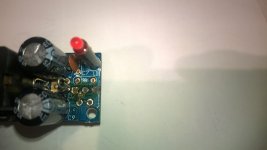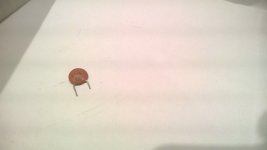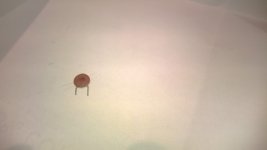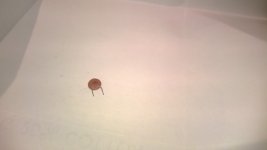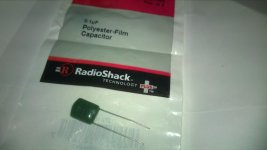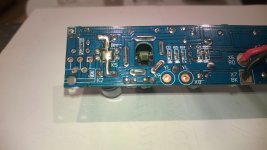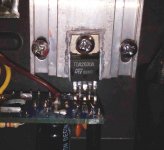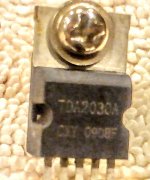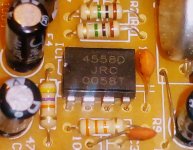You will have +/-19V rails, probably 18V real world.
You will NOT increase power by going to a TDA ´40 or ´50 since power supply is the same and no, it´s not worth touching it.
Better get a real TDA2030 (from a reputable supplier such as Mouser, Digikey or Farnel) rather than a dubious "Ebay" one; and sadly *forget* about TDA2040/50 (unless you had one stashed for 6 years or more) because both have been discontinued LONG ago (which is the content of this very thread )
)
A better option is still made LM1875.
Just repair amp as is and enjoy it.
You will NOT increase power by going to a TDA ´40 or ´50 since power supply is the same and no, it´s not worth touching it.
Better get a real TDA2030 (from a reputable supplier such as Mouser, Digikey or Farnel) rather than a dubious "Ebay" one; and sadly *forget* about TDA2040/50 (unless you had one stashed for 6 years or more) because both have been discontinued LONG ago (which is the content of this very thread
A better option is still made LM1875.
Just repair amp as is and enjoy it.
Thank you for accepting my post and the fast reply. For some reason, I am going on a limb here by asking rudimentary questions, but also because I do not mean to hijack the thread, although it is a very old one. I can start a new thread if needed. Please let me know.
So, I inherited a broken Behringer AT108 acoustic instrument combo amplifier. When turned ON it makes a continuous booming low frequency noise and I noticed the speaker cone moves all the way to the back and does not come at the resting (mid) position unless I turn it off.
I looked inside it is based on a TI074C and a D2030A. I happen to have a 2030 laying around so I will just try to replace that and see what happens. I also tested the PSU and (I think it is working fine) it produces 13.4V AC between the brown wire and any of the two yellow wires, while between the two yellows I read (as expected) double that, eg 26.8V AC. Now I have no sure way to measure how much DC actually reaches the power amp, so what I'll do is when I remove the IC I will turn on and measure at pads (pins) 3 and 5. I expect to read around 30-35V DC. I hope I won't make things worse, but my hunch is it's just the power amp IC is bad which should be an easy repair. What do you think?
And finally,
1. What other component(s) around the power amp IC should I check before I replace it. I am afraid whatever caused the bad IC will again "fry" the new 2030 as well. Could the 2030 have gone bad on ...its own?
2. Given the attached datasheets, it looks as if the 2040 is a pin for pin replacement for the 2030 and assuming the provided voltage is around 30V DC, without any other circuit modifications, it will produce about 20W a nice improvement from the claimed stock of 15W. Am I correct about this?
Thank you for your help! Let's see if with your help I can resurrect this little amp!?
One advantage with class AB (such as TDA2030) is that you can test the circuit without a speaker connected and get a very good indication of the state of the amplifier circuit. It may be the TDA2030 that is defect but it may also be one of the electrolytic capacitors. In particular, I would suspect the coupling capacitor at the output, between TDA2030 pin 4 and the speaker. The reason: The fact that the speaker goes to the back indicates a DC across the speaker. The output coupling capacitor should prevent such a DC - unless it is defect.
So, disconnect the speakers, short-circuit the inputs to ground through 1KOhm and turn the power on. First, check the supply voltage and if anything becomes particularly hot. Then, is the voltage at TDA2030 pin 4 around half of the supply voltage? If yes, it is most likely the output capacitor that is defect. If no, why is the amplifier not in regulation?
Don't bother looking for a TDA2040, it will bring you no significant improvement. Rather a good TDA2030 as recommended by Mr. Fahey.
Last edited:
Thank you both for the feedback. I am scrapping the idea of the 2040 (good luck finding one, right?) and focusing on the repair.
By the time I got the 2nd reply from ..."FakeFrench" (great alias btw) it was already too late, I had removed the speaker and tested voltages but without shorting the speaker leads using the 1KΩ to ground. I just disconnected the speaker and made sure the leads did not touch. I hope I did not make it worse... ?
Here's what I found: The PSU brings in 26.8V AC exactly as I described in the previous post, e.g. 13.4V on each yellow wire (x2) to brown (=ground). Now between pin 3 and 5 at the 2030 I was reading about 30 V DC, actually it was fluctuating +/- .3V around 30.5V DC.
So, I removed the IC (not the cleanest job but I checked pad connectivity and it should be OK). One thing that bothered me is a capacitor in series between pin 3 and the brown PSU cable but not pin 4 that goes to a 15K resistor and then I can't trace it. Anyway the cap is a 104 M ceramic disk (100nF) it has no sign of bulging or anything else just has a bit of brownish discoloration on one side, what do you think? Should I replace that as well? Problem is it's getting late here in Chicago right now and I do have a 0.1μF but it is a radio shack (green) polyester film. Is it ok to put in place of an (orange) ceramic disk?
That's all for now, thank you for the patience.
By the time I got the 2nd reply from ..."FakeFrench" (great alias btw) it was already too late, I had removed the speaker and tested voltages but without shorting the speaker leads using the 1KΩ to ground. I just disconnected the speaker and made sure the leads did not touch. I hope I did not make it worse... ?
Here's what I found: The PSU brings in 26.8V AC exactly as I described in the previous post, e.g. 13.4V on each yellow wire (x2) to brown (=ground). Now between pin 3 and 5 at the 2030 I was reading about 30 V DC, actually it was fluctuating +/- .3V around 30.5V DC.
So, I removed the IC (not the cleanest job but I checked pad connectivity and it should be OK). One thing that bothered me is a capacitor in series between pin 3 and the brown PSU cable but not pin 4 that goes to a 15K resistor and then I can't trace it. Anyway the cap is a 104 M ceramic disk (100nF) it has no sign of bulging or anything else just has a bit of brownish discoloration on one side, what do you think? Should I replace that as well? Problem is it's getting late here in Chicago right now and I do have a 0.1μF but it is a radio shack (green) polyester film. Is it ok to put in place of an (orange) ceramic disk?
That's all for now, thank you for the patience.
Attachments
Yes, you can use polyester film instead of a ceramic disc.
No, test without grounding the inputs hardly made further damage. An open input tends to pick up hum and makes static measurements difficult.
Now the IC is anyway out, check without power all your electrolytic capacitors with an Ohm-meter. Red probe to capacitor "+" and black probe to capacitor "-". Check for steady low impedance (indicates defect).
No, test without grounding the inputs hardly made further damage. An open input tends to pick up hum and makes static measurements difficult.
Now the IC is anyway out, check without power all your electrolytic capacitors with an Ohm-meter. Red probe to capacitor "+" and black probe to capacitor "-". Check for steady low impedance (indicates defect).
Thanks, I just checked all electrolytic capacitors, at low 200Ω scale, observing correct polarity, all check fine (actually at initial contact the display appears flashing a random number but in a second it settles to a solid 1. I take that is OK !?). Btw, can I test the ceramic that way, I do not think so (I tried anyway with red/black probe both ways, again no resistance present. I am zeroing to the 2030 being toast, the guy who gave it to me said it stopped working after a minor flood in his basement, however, I found little evidence of rust on the components, some on the chassis but negligible. Anyway, off to get a 2030 so I went looking for the spare 2030 I (thought I) have, it is a 2003, darn it! So now I am off to my friend's John store (Minstrel Music in Niles, IL) he also repairs amps (mostly tubes) but said he should have one 2030 laying around. It's almost a 1/2 hr drive so I got to be there before 8 pm when he closes. I'll report later, I am obliged to all of you for the support, just amazing!
BG Micro still has TDA2030’s - with the old SGS logo on them. The only question is whether they are real. “New” production with the “ST” logo would be more likely to be faked, the old “SGS” could be genuine NOS. I did buy a dozen of the SGS TDA2002’s from them and they worked perfectly, so their 2030 batch may be good. It’s only two bucks to find out. Other vintage parts I’ve bought from there over the years have been good, but it’s usually stuff no one in their right mind would fake.
OK SUCCESS !!!
Nothing else was bad on the circuit, my friend John confirmed all caps were in tact and he found me a TDA2030A (which appears to be authentic) installed and the amp sounds fine, actually compared to a similar one he had at the store mine sounds so much quieter now with the IC replacement.
I do not get paid by Behringer to say this but the AT108 is actually a decent little "acoustic" amp for the money, it sounds way much better of course plugged into a bigger cabinet with a much better speaker or even fed thru a console with FX and via a good PA. I wonder which amp Behringer's ..."RD" department tried to ... "emulate" and created this one. Not bad at all for a decent 15W (claimed) output.
So, I would like to thank you all for your kindness and patience and advice. Also thanks for the BG Micro info for ~$2 a piece I'll give it a try; I did find the spare TDA2030A ICs I had, but I do not trust them, they came from cannibalizing a few cheap FirstAct little toy-amps along with some JRC4558D. If you have time look at the pics (and the inscriptions) do they look authentic to you? I don't know, but I doubt it, these amps were made in China for ToysRus and at their lowest they were selling on closeout for something like $4.99 a piece. Hard to be using original (let alone NOS 4558D) at such a low price.
Well, that was fun, thank you all again!
PS: Mr. Fahey, have n't we also met years ago at a SSguitar forum?! I think so. If I am right, it is good to run into you and your wealth of knowledge again! Is it OK to bother you with a technical question via a PM (I've hijacked this thread enough!). Thank you!
Nothing else was bad on the circuit, my friend John confirmed all caps were in tact and he found me a TDA2030A (which appears to be authentic) installed and the amp sounds fine, actually compared to a similar one he had at the store mine sounds so much quieter now with the IC replacement.
I do not get paid by Behringer to say this but the AT108 is actually a decent little "acoustic" amp for the money, it sounds way much better of course plugged into a bigger cabinet with a much better speaker or even fed thru a console with FX and via a good PA. I wonder which amp Behringer's ..."RD" department tried to ... "emulate" and created this one. Not bad at all for a decent 15W (claimed) output.
So, I would like to thank you all for your kindness and patience and advice. Also thanks for the BG Micro info for ~$2 a piece I'll give it a try; I did find the spare TDA2030A ICs I had, but I do not trust them, they came from cannibalizing a few cheap FirstAct little toy-amps along with some JRC4558D. If you have time look at the pics (and the inscriptions) do they look authentic to you? I don't know, but I doubt it, these amps were made in China for ToysRus and at their lowest they were selling on closeout for something like $4.99 a piece. Hard to be using original (let alone NOS 4558D) at such a low price.
Well, that was fun, thank you all again!
PS: Mr. Fahey, have n't we also met years ago at a SSguitar forum?! I think so. If I am right, it is good to run into you and your wealth of knowledge again! Is it OK to bother you with a technical question via a PM (I've hijacked this thread enough!). Thank you!
Attachments
Last edited:
- Status
- This old topic is closed. If you want to reopen this topic, contact a moderator using the "Report Post" button.
- Home
- Amplifiers
- Chip Amps
- A sad day for 5 pin chip amps
